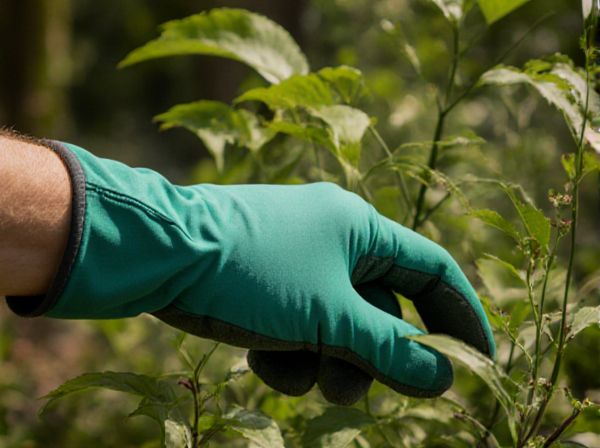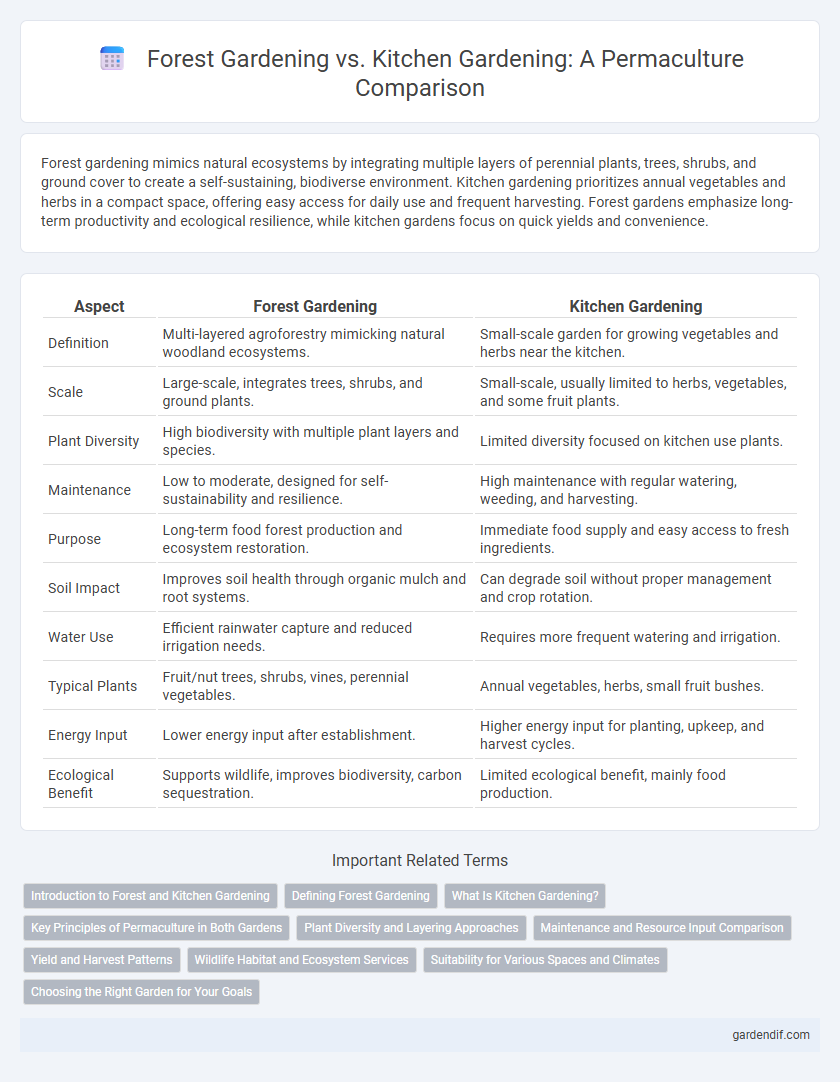
Forest Gardening vs Kitchen Gardening Illustration
Forest gardening mimics natural ecosystems by integrating multiple layers of perennial plants, trees, shrubs, and ground cover to create a self-sustaining, biodiverse environment. Kitchen gardening prioritizes annual vegetables and herbs in a compact space, offering easy access for daily use and frequent harvesting. Forest gardens emphasize long-term productivity and ecological resilience, while kitchen gardens focus on quick yields and convenience.
Table of Comparison
| Aspect | Forest Gardening | Kitchen Gardening |
|---|---|---|
| Definition | Multi-layered agroforestry mimicking natural woodland ecosystems. | Small-scale garden for growing vegetables and herbs near the kitchen. |
| Scale | Large-scale, integrates trees, shrubs, and ground plants. | Small-scale, usually limited to herbs, vegetables, and some fruit plants. |
| Plant Diversity | High biodiversity with multiple plant layers and species. | Limited diversity focused on kitchen use plants. |
| Maintenance | Low to moderate, designed for self-sustainability and resilience. | High maintenance with regular watering, weeding, and harvesting. |
| Purpose | Long-term food forest production and ecosystem restoration. | Immediate food supply and easy access to fresh ingredients. |
| Soil Impact | Improves soil health through organic mulch and root systems. | Can degrade soil without proper management and crop rotation. |
| Water Use | Efficient rainwater capture and reduced irrigation needs. | Requires more frequent watering and irrigation. |
| Typical Plants | Fruit/nut trees, shrubs, vines, perennial vegetables. | Annual vegetables, herbs, small fruit bushes. |
| Energy Input | Lower energy input after establishment. | Higher energy input for planting, upkeep, and harvest cycles. |
| Ecological Benefit | Supports wildlife, improves biodiversity, carbon sequestration. | Limited ecological benefit, mainly food production. |
Introduction to Forest and Kitchen Gardening
Forest gardening mimics natural woodland ecosystems by integrating diverse layers of perennial plants, trees, and shrubs to create a sustainable, self-maintaining food production system. Kitchen gardening involves cultivating vegetables, herbs, and fruits in a small, intensively managed space close to the home for immediate consumption. Both methods prioritize organic practices, but forest gardening emphasizes long-term ecological balance while kitchen gardening focuses on quick, high-yield harvests.
Defining Forest Gardening
Forest gardening is a sustainable agricultural practice that mimics natural forest ecosystems by integrating diverse layers of perennial plants, including trees, shrubs, herbs, and ground covers. This method promotes biodiversity, soil health, and resilience, creating self-sustaining food production systems with minimal human intervention. Unlike kitchen gardening, which typically focuses on annual vegetables in small plots, forest gardening emphasizes long-term ecological balance and perennial yields.
What Is Kitchen Gardening?
Kitchen gardening involves cultivating a small-scale garden near the home, focusing on growing vegetables, herbs, and fruits for daily household use. It emphasizes efficient space utilization and easy access for fresh, organic produce, often employing raised beds or container gardening techniques. This method supports sustainable living by reducing food miles and promoting self-sufficiency in food production.
Key Principles of Permaculture in Both Gardens
Forest gardening emphasizes layered planting with perennial species to create a self-sustaining ecosystem that mimics natural forests, enhancing biodiversity and soil health. Kitchen gardening focuses on intensive, seasonal cultivation of annual vegetables and herbs for immediate food production while incorporating crop rotation and companion planting to optimize space and nutrient cycling. Both gardens apply core permaculture principles such as observing natural patterns, maximizing resource efficiency, and fostering resilience through diversity and ecological balance.
Plant Diversity and Layering Approaches
Forest gardening emphasizes high plant diversity through multi-layered systems, incorporating canopy trees, shrubs, herbaceous plants, ground covers, and root crops to mimic natural ecosystems. Kitchen gardening focuses on simplified plant diversity with primarily herbaceous vegetables and herbs grown in single-layer beds or containers. The layering approach in forest gardening enhances resource efficiency and ecological resilience, while kitchen gardening prioritizes ease of access and rapid harvest cycles.
Maintenance and Resource Input Comparison
Forest gardening requires minimal maintenance due to its self-sustaining ecosystem that mimics natural forests, promoting biodiversity and soil health with low external inputs. Kitchen gardening demands regular watering, weeding, and fertilization, often relying on more intensive resource inputs for higher yields of annual crops. Resource efficiency in forest gardening reduces labor and material costs, while kitchen gardening typically involves greater investment in time and resources to maintain productivity.
Yield and Harvest Patterns
Forest gardening emphasizes multi-layered, perennial plants that produce continuous and diverse yields throughout the year, promoting ecological balance and long-term soil health. Kitchen gardening typically provides higher immediate yields of annual vegetables and herbs in concentrated harvest periods, catering to frequent kitchen use. Yield patterns in forest gardens are more staggered and sustainable, while kitchen gardens focus on quick, intensive productivity.
Wildlife Habitat and Ecosystem Services
Forest gardening integrates diverse layers of perennial plants that create complex habitats supporting a wide range of wildlife species, enhancing pollinator activity and providing shelter for birds and beneficial insects. Kitchen gardening typically involves annual crops with limited structural diversity, offering fewer opportunities for wildlife habitat and ecosystem services such as soil stabilization and water regulation. The perennial nature and multilayered canopy of forest gardens contribute significantly to biodiversity conservation and ecosystem resilience compared to the simplified monoculture often found in kitchen gardens.
Suitability for Various Spaces and Climates
Forest gardening thrives in larger, diverse spaces with layered vegetation, adapting well to temperate and tropical climates due to its perennial plant systems and natural ecosystem mimicry. Kitchen gardening suits smaller, controlled environments like urban backyards or patios, enabling cultivation of annual vegetables and herbs in various climates through seasonal adjustments. Both methods optimize space use, but forest gardening emphasizes long-term sustainability and biodiversity, whereas kitchen gardening focuses on immediate, accessible food production.
Choosing the Right Garden for Your Goals
Forest gardening emphasizes perennial plants and layered planting, creating a self-sustaining ecosystem that mimics natural forests, ideal for long-term food production and biodiversity. Kitchen gardening focuses on annual vegetables and herbs planted in manageable beds, offering quick harvests and easy maintenance suitable for small spaces and immediate consumption. Selecting between these methods depends on your goals: choose forest gardening for sustainable yields and ecological benefits, or kitchen gardening for convenience and fast-growing crops.
Forest Gardening vs Kitchen Gardening Infographic

 gardendif.com
gardendif.com